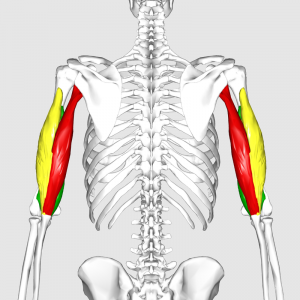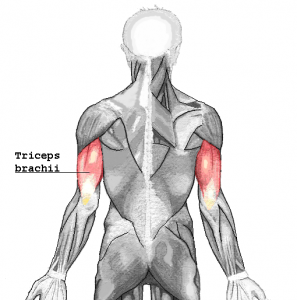The triceps brachii muscle runs along the humerus— the upper arm bone between the shoulder and the elbow.
The triceps brachii is mainly responsible for the extension of the elbow joint—anatomy speak for straightening the arm—though it also helps to stabilize the relatively insecure shoulder joint.
The triceps mainly work antagonistically to the biceps brachii together finding the balance to flex and extend the elbow.
The biceps do have two other flexors, brachialis and brachioradialis, that work along with it to oppose the triceps, the lone extensor muscle.
These opposing muscles are simply more powerful than the triceps, the result of which is the slight bend you often see at the elbow when our arms hang freely.
The triceps muscle has three heads (as its name implies), a long head, a lateral head, and a medial head. The long head connects at the top to the scapula on its upper outer border just below the shoulder joint.
The other two heads connect on the upper arm.
Together they meet to form a large common tendon that inserts on the olecranon, the bony point of the elbow.
The long head of the triceps brachii extends the arm at the shoulder while the lateral and medial heads extend the forearm at the elbow
A few weeks back I wrote about the revelation of moving my pinky finger in a bit to line it up with the outer edge of the palm creating a straight line from the outer wrist to the tip of the pinky finger.
This slight, yet game changing movement, helps to facilitate the triceps and has had a wonderful effect throughout the practice especially with inversions.
In handstand, the triceps brachii extend the elbows; in headstand they stabilize the elbows; and in one of my favorite poses— forearm stand (pincha mayurasana)—the action of the triceps brachii resists the flexion of the elbows pulling the shoulders over the elbows, and the arm bone perpendicular to the floor.
That pinky thing has really been stupendous.
***



